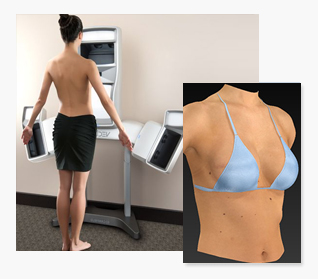Bay Area Plastic Surgeon John R. Griffin performs breast augmentation to enhance the size and shape of the breasts. Learn more about who is a good candidate for the procedure, the surgical techniques that can be performed, and the breast augmentation recovery period.
Vectra 3D Imaging for Breast Augmentation
|
Vectra 3D imaging technology helps women visualize their potential individual outcomes. During the breast augmentation consultation, Dr. Griffin will take a 3D image of the patient. Once the image is displayed on his computer screen, Dr. Griffin can adjust the breast implant volume and profile to help patients pinpoint, with greater accuracy, the implant size that they desire. The simulated images can be viewed from all angles, giving patients a better idea of what their surgical results could look like. |
Vectra 3D imaging technology helps women visualize their potential individual outcomes. During the breast augmentation consultation, Dr. Griffin will take a 3D image of the patient. Once the image is displayed on his computer screen, Dr. Griffin can adjust the breast implant volume and profile to help patients pinpoint, with greater accuracy, the implant size that they desire. The simulated images can be viewed from all angles, giving patients a better idea of what their surgical results could look like.
Breast Augmentation Candidates
Breast augmentation with silicone or saline implants is a refined option for patients who wish to enhance their breast size and shape. Breast augmentation can treat:
- Small breasts
- Breast asymmetry
- Tubular breasts
Breast augmentation candidates should be in good health with realistic expectations about the results of surgery.
- Age restrictions: Patients having saline implants placed should be at least 18 years of age; patients having silicone gel implants placed should be at least 22 years of age.
- Other restrictions: Breast augmentation patients should not be pregnant or breastfeeding, suffering from an infection or cancer, or a regular smoker.
Breast Augmentation Surgical Techniques
Dr. Griffin will advise breast augmentation patients on the most suitable incision and placement approach for their surgeries.
Incision Technique
The incision technique refers to the location of the incision that is created to access the underlying anatomy of the breast. Two incision approaches give Dr. Griffin direct access to the breast muscle and pocket:
- Infra Mammary: This incision gives Dr. Griffin the greatest control over breast implant placement and pocket creation. It can also be re-used in the case of breast implant revision surgery. In most patients, the infra mammary incision is actually the most "invisible" incision, as in most patients, the shadow and curvature of the breast hides the incision well. This incision also allows the surgeon to avoid dissection across the breast gland, providing ready access to the implant pocket under the muscle. There may be advantages to this approach in terms of capsular contracture rates and infection rates.
- Periareolar: The periareolar incision is well masked at the border of the areola where the darker pigment of the areola transitions to the lighter breast skin. This approach still offers a high level of precision in terms of pocket creation and implant placement; it is also ideal for patients undergoing a simultaneous breast lift, as the same incisions can be used. However, there are some limitations as to the size of implants that can be placed with the periareolar approach.
- Endoscopic Axillary Breast Augmentation: Although the infra mammary and periareolar incision techniques produce minimal scarring, some patients prefer no scar on the breast itself, and would like to have implants placed via incisions at the anterior aspect of the underarm. Dr. Griffin is well versed in this technique, and offers it to select patients. This technique is most suited for patients who have minimal to no breast ptosis, good symmetry, and good breast skin tone. This approach involves the creation of a tunnel, or channel, that runs from the incision site to the breast. The downside of this technique is that it is more difficult to accurately place the implants. The advantage is that scarring is limited to the armpits.
Placement Technique
Dr. Griffin’s patients may have their breast implants placed above or below the pectoralis muscle. In the majority of cases, implants are placed below the muscle (the submuscular approach). The submuscular method offers more natural results and is associated with a reduced risk of capsular contracture. However, implants may be placed above the chest muscle (subglandular) if the patient has adequate tissue thickness. Dr. Griffin will evaluate a patient’s anatomy before recommending the best surgical placement approach.
To reduce the risk of infection and post-surgical complications, Dr. Griffin employs the use of the No-Skin-Touch technique, where silicone implants are delivered into the pocket through a sterile funnel device, which lessens stress on the tissues and protects the implant from the skin.
He also practices the meticulous sterile technique, involving multiple protective steps and precautions. This includes use of antibiotic solutions for the implants and the implant pockets.
Breast Augmentation Procedural Steps
The breast augmentation procedure is broken down into several stages. First, Dr. Griffin and his nurses prepare patients for surgery by having them change into a surgical dressing gown. Then, Dr. Griffin performs a final examination of the breasts and marks the incision locations with a special surgical pen. Next, the patient is brought to the operating room where an antibacterial solution is applied to the breasts or other incision sites. Finally, the patient is put under anesthesia. Once the patient is fully sedated, the surgery process will begin:
- Incisions are made on the breast or armpits
- The breast implant pocket is created
- The breast implant is placed and properly positioned within the pocket
- If saline implants are placed, the saline solution is added to inflate the implants
- Before closing the incision, the process is repeated on the other side
- The breasts are checked for symmetry and final adjustments are made to the positioning of both implants
- The incisions are closed with sutures
- Dressing is applied to the breasts; this may include the use of gauze, medical tape, Ace bandages, and support bras
Breast Augmentation Recovery Period
Upon their return home from surgery, patients should keep the dressing in place, rest with the head elevated, and take pain medication as needed. This should be continued for the first 48 hours after surgery.
In general, patients can expect to shower two days after surgery, and return to work one week after surgery. For the first four to six weeks after surgery, patients should avoid strenuous activity and wear a surgical bra.
Breast Augmentation Side Effects and Risks
Breast augmentation side effects are common and tend to be fairly mild. Patients may experience:
- Pain, which can be relieved with pain medication
- Swelling
- Bruising
- Itching, numbness, or tingling at the incision site
While the side effects of surgery are generally not cause for concern, complications may arise as a result of breast augmentation surgery. Possible breast augmentation complications include:
- Allergic reaction to anesthesia or medication
- Infection
- Changes in nipple sensation
- Implant leaks or deflation
- Implant rippling
- Implant displacement
- Capsular contracture
- Bottoming out
- Symmastia
- Pocket problems
Breast Augmentation Results
The results of breast augmentation are immediately apparent. However, the appearance of the breasts will continue to improve during the first few months after surgery. During the first three months and up to a year after surgery, patients may have some residual swelling and the implants may sit high on the chest. As the swelling fades and the implants settle, patients can enjoy the final outcome of their breast augmentation surgery.
The results of breast augmentation last a decade or longer for most patients. However, breast implants are not lifetime devices; if they wear out due to leak or rupture, or become affected by another complication such as capsular contracture, the implants will need to be removed and replaced.
Breast Augmentation Consultations
Contact the practice of Dr. John R. Griffin, serving San Francisco and other Bay Area cities, to schedule a breast augmentation consultation.








